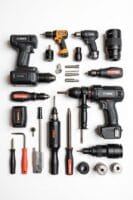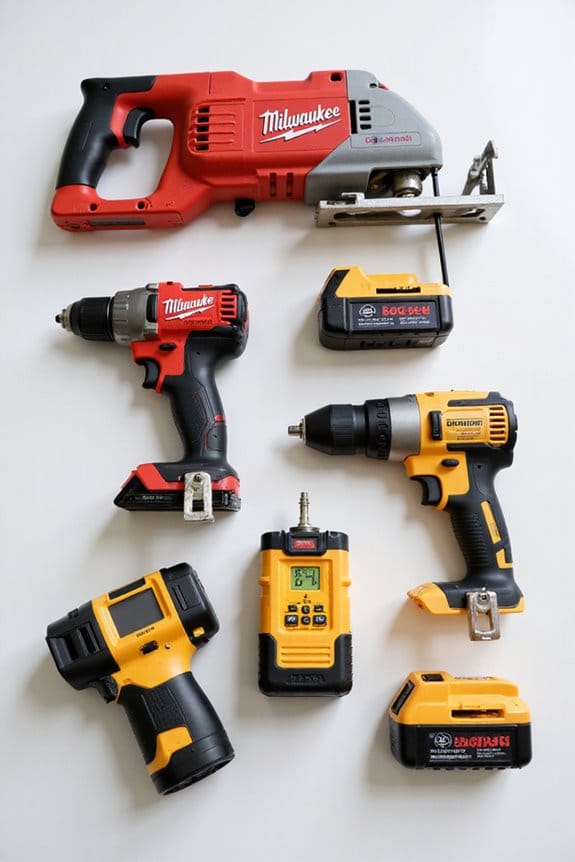When using power tools, I always gear up for safety. First, I wear impact-resistant safety glasses for eye protection. Next, I grab ear protection if it’s noisy—earplugs or earmuffs work well. Then, I put on cut-resistant gloves and durable clothing to shield my hands and body. Don’t forget sturdy, non-slip footwear. Finally, make sure you inspect your tools regularly. Stick around, and you’ll pick up more tips to stay safe while getting the job done!
Key Takeaways
- Wear impact-resistant safety glasses or goggles to protect against dust and flying debris while using power tools.
- Utilize hearing protection like earmuffs or foam plugs when operating tools that exceed noise levels of 85 dBA.
- Choose appropriate gloves based on the task to protect hands from cuts, scrapes, and heat.
- Don snug, durable clothing and safety footwear with toe caps to prevent injuries from moving parts and falling objects.
- Ensure respiratory protection is used in environments with hazardous dust or fumes, especially with air-purifying respirators.
Eye and Face Protection
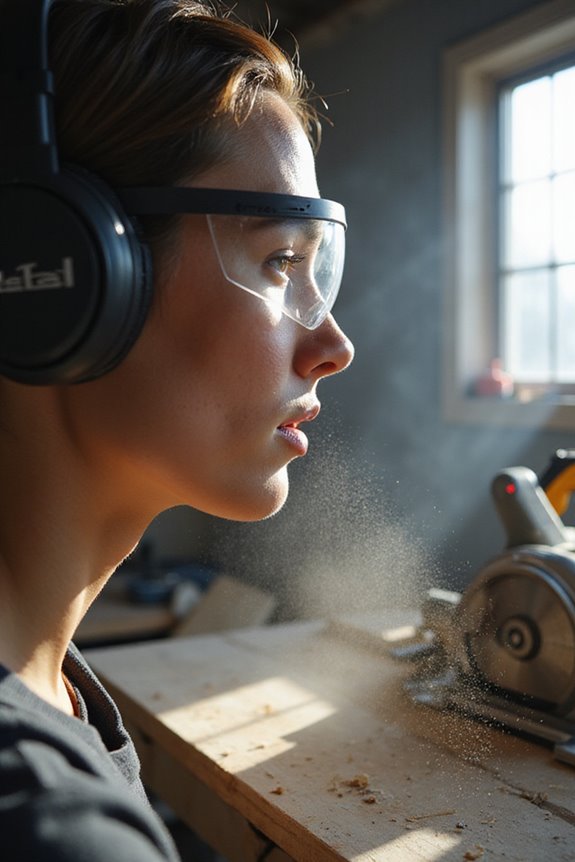
When you’re working with power tools, you can’t underestimate the importance of eye and face protection. Here’s what I recommend:
- Safety Glasses: Go for impact-resistant glasses. If you want extra protection, look for ones with side shields. They really help against flying debris.
- Goggles: With various goggle types available, pick ones that seal around your eyes. They’re great for dust and splashes.
- Face Shields: Made from materials like vulcanized fiber, they protect your face from splashes. Just remember, face shields alone aren’t enough. Pair them with safety glasses or goggles for full protection.
Always check that your gear meets safety standards. Trust me, your eyes and face will thank you for it!
Hearing Protection
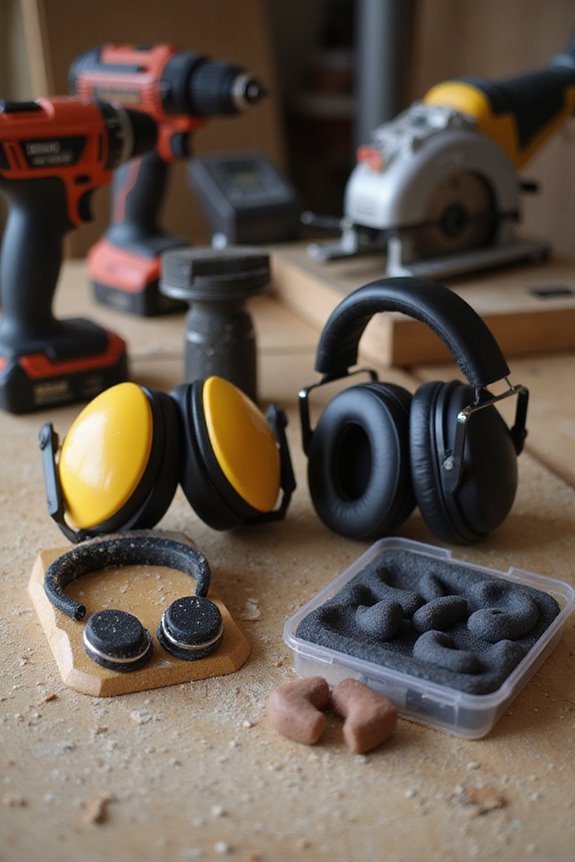
Hearing protection is a must-have when using power tools, and let’s face it, your ears deserve a little TLC too. Here’s why: prolonged noise exposure can lead to hearing loss, and that’s not something you want to risk.
- Types of Protection: You’ve got options like earmuffs and foam plugs. Both can save your hearing, but choose based on comfort and noise levels.
- Know Your Limits: If the noise exceeds 85 dBA, it’s time to gear up. For really loud tools, consider double hearing protection.
- Maintenance Matters: Regularly check your gear for wear and tear.
- Training: Learn how to wear them properly. It’s all about hearing conservation, after all! Keep those ears safe, folks!
Hand Protection
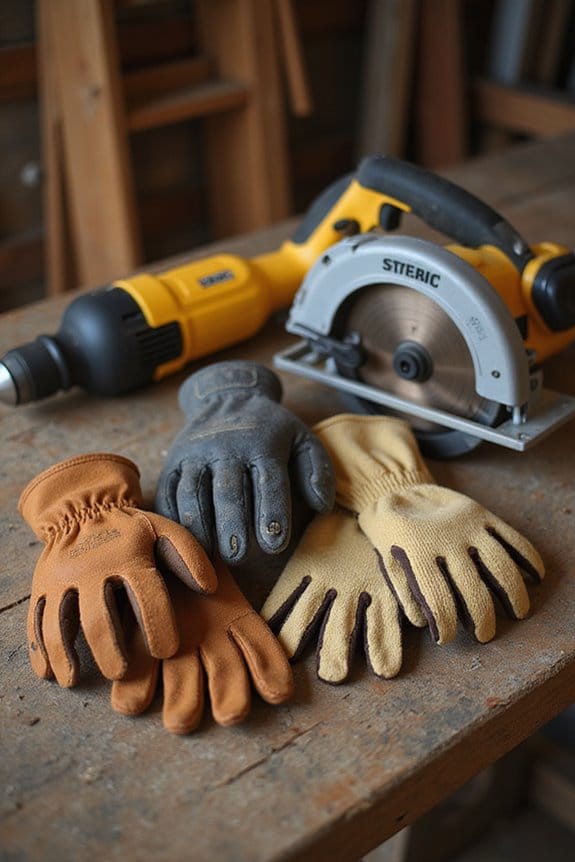
After taking care of your ears, it’s time to turn our attention to those hardworking hands. Choosing the right gloves is essential for hand protection. Here are some tips:
- Glove Materials: Leather gloves are tough and great for heat, while cotton gloves are comfy but less protective. Consider cut-resistant options, but remember—they won’t save you from moving blades!
- Glove Fit: Make sure your gloves fit snugly. Loose gloves can catch on machinery, leading to nasty surprises. You want to maintain dexterity for safe tool handling.
Before starting work, check your gloves for damage. They should protect against scrapes and punctures, but never replace safe operating practices. Remember, gloves can’t do all the heavy lifting—safety starts with you!
Respiratory Protection

Have you ever thought about what you’re breathing in while working with power tools? It’s not just sawdust; it could be harmful fumes too! That’s why understanding respiratory protection is vital. Here are a few respirator types you might consider:
- Air-purifying respirators (APR): Great for filtering out particulates.
- Full-facepiece respirators: They provide eye protection along with filtration.
- Powered air-purifying respirators (PAPR): These enhance airflow for comfort.
- Self-contained breathing apparatus (SCBA): Ideal for extremely hazardous environments.
Employers need to establish safety programs, including training and fit testing, to guarantee you’re protected. Remember, proper respiratory gear isn’t just a suggestion; it’s essential for your health while using power tools! Stay safe out there!
Clothing Safety
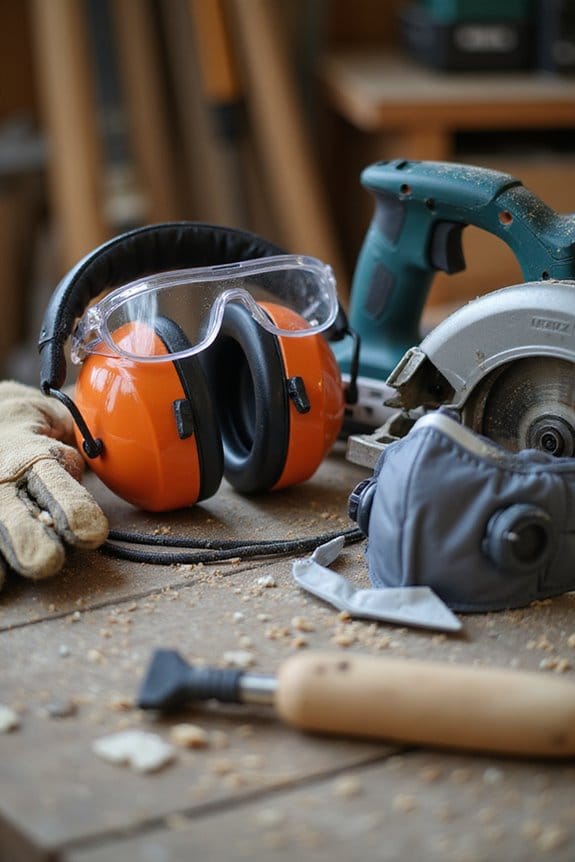
While we’ve covered respiratory protection, let’s not forget about what we wear when using power tools. Clothing safety is essential, so here are some guidelines:
- Proper Fit: Wear snug clothing to avoid loose ends getting caught in tools. Long sleeves should be tight or rolled up, and skip the jewelry—rings and bracelets can be dangerous.
- Hair Restraint: If you have long hair, tie it back or use a headband. This keeps hair away from moving parts and reduces distractions.
- Material Choice: Choose durable fabrics that protect against sparks or debris—cotton or flame-resistant clothing is ideal.
Footwear Safety
Footwear safety is essential when working with power tools—after all, you wouldn’t want to end up with an unfortunate toe incident, right? Here are some vital points to keep in mind:
- Footwear Types: Look for safety toe caps that meet ASTM F2413 standards. They protect against impact and compression, with ratings like I/75 for added assurance.
- Slip Resistance: Choose non-slip footwear. This helps avoid falls, especially on slick surfaces.
- Ankle Support: Properly fitted shoes with good ankle support can prevent twists and sprains during quick movements.
- Hazard-Specific Options: If you’re near electrical hazards, consider EH-rated footwear for extra protection.
Electrical Safety Measures
When you’re focused on keeping your feet safe while using power tools, it’s just as important to contemplate electrical safety measures. Here are a few tips I swear by:
- Cord Management: Never carry tools by their cords. Keep them clear of heat sources and sharp edges to avoid damage. Always unplug by gripping the plug, not yanking the cord.
- Tool Maintenance: Regularly inspect your tools for any damage. If you notice frayed cords or malfunctioning switches, tag them as “Do Not Use” until fixed.
- Safe Environment: Avoid using electric tools in damp areas unless they’re specifically rated for it. And remember, a well-lit workspace helps prevent accidents!
Importance of Safety Guards
Safety guards are essential tools that keep us safe from the dangers of power tools, and I can’t stress enough how important they are. Here’s why you should take them seriously:
- Physical Barriers: Guards protect us from moving parts, reducing risks of lacerations and amputations.
- Debris Control: They contain flying debris, helping prevent eye and facial injuries.
- Dust and Sparks: Proper guards control dust and sparks, minimizing fire hazards.
- Encouraged Behavior: They promote safer tool handling by restricting access to dangerous areas.
To guarantee guard effectiveness, always check for proper installation and alignment. Regular guard maintenance is vital—repair or replace any damaged components immediately. Additionally, ensure your tools meet local electrical specifications to further enhance safety during operation. Trust me, it’s better to be safe than sorry!
Regular Equipment Inspection
Regular equipment inspection is a critical habit that can save you from potential accidents and costly repairs. Here’s a quick inspection checklist I follow:
- Visual Check: Look for cracks or dents on the tool body and handle. Check blades for wear and verify cords aren’t frayed.
- Electrical Integrity: Verify plugs are intact and switches function properly. Grounding is key to avoiding shocks!
- Operational Check: Power the tool on and off, listening for unusual noises. This helps catch motor issues early.
- Maintenance: Clean your tools after use and lubricate moving parts as recommended. This keeps everything running smoothly. Additionally, regular calibration of your tools ensures accuracy in electrical testing and enhances their longevity.
General Safety Practices
While using power tools can be empowering, it’s essential to prioritize general safety practices to keep accidents at bay. Here’s what I recommend:
- Tool Maintenance: Always keep your tools clean and sharp. A well-maintained tool is a safer tool. Disconnect them before servicing!
- Worksite Management: Maintain a tidy work area. Clutter can lead to slips, trips, and falls.
- Stay Alert: Focus on your task. Distractions can be dangerous.
- Proper Gear: Wear gloves, safety glasses, and ear protection. Trust me, your future self will thank you!
- Secure Workpieces: Use clamps to stabilize items. This way, you can keep both hands on the tool.
- Ergonomic Design: Consider using tools designed with ergonomic features to reduce fatigue and improve control during use.
Frequently Asked Questions
How Do I Choose the Right Safety Goggles for My Needs?
When I choose safety goggles, I consider lens materials for impact resistance and fit options for comfort. It’s essential they seal well, ensuring protection against debris and hazards in my specific work environment.
Are There Specific Gloves for Different Types of Power Tools?
Imagine your hands as the knights protecting your castle. Different power tools require specific gloves: reinforced leather for durability, anti-vibration padding for comfort, and breathable materials to keep cool. Choosing wisely can safeguard your hands effectively.
What Should I Do if My Safety Gear Gets Damaged?
If my safety gear gets damaged, I immediately follow damaged equipment procedures. I’d remove it from use, report the issue, and prioritize safety gear maintenance to guarantee I’m protected next time I work.
How Often Should I Replace My Hearing Protection Equipment?
I’ve learned that hearing protection lifespan varies greatly. While I replace foam plugs after each use, I also follow noise exposure guidelines to determine when earmuffs need replacing—keeping my hearing safe is always a priority.
Is It Necessary to Wear a Helmet When Using Power Tools?
I believe wearing a helmet’s essential for power tool safety. The helmet’s importance can’t be overstated; it protects against falling debris and electrical hazards, reducing the risk of serious head injuries in hazardous environments.


